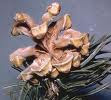Chilgoza pine nuts come from the Chilgoza pine tree which is found in the north western Himalayan region. Its range extends from Garhwal to Baluchistan in Pakistan and on to Afghanistan, and is mainly found in the upper valleys of the rivers Chennai, Ravi and Sutlej, at altitudes of between 5500 and 9000 feet. It is a hardy tree which can withstand cold and drought and requires little soil, so it is extremely valuable to the ecology of hilly regions as it helps prevent erosion. It has little commercial value for its timber, but can be used as fuel, which is why Chilgoza forests are being depleted. There are initiatives to replant trees that have been felled, and an educational program which is intended to promote the conservation of the trees in Himachal Pradesh in India and in the Suleiman mountain range of Pakistan. Chilgoza are exported all over the world.
 The seed is cylindrical and 2 to 3 centimetres long, with a dark brown outer skin, which has to be removed before eating. This is used by small children to make “windmills” with thin pieces of tree bark or twigs. They blow on the skin to make it turn like a fan. The seeds contain palmitic, stearic, oleic and linoleic fatty acids and contain the minerals calcium, phosphorous and iron, mainly. They also contain vitamins B2 (riboflavin) and B3 (niacin). The tree exudes an oleoresin when tapped which is a good source of turpentine oil. In the subcontinent the pine nuts are used as a general tonic, a nutrient and an aphrodisiac, as they reputedly increase a man’s sperm count and help with erection problems. They are used to treat chronic arthritis, taken with honey, and are stimulants, and help with the treatment of a number of skin problems including ringworm, acne, eczema and dry skin. The seed oil is used as a dressing for sores, and wounds. The cones contain a white resin which is used to patch up wooden containers. The bark of the tree is used to make baskets and buckets as is the bark of the Shahtoot mulberry tree.
The seed is cylindrical and 2 to 3 centimetres long, with a dark brown outer skin, which has to be removed before eating. This is used by small children to make “windmills” with thin pieces of tree bark or twigs. They blow on the skin to make it turn like a fan. The seeds contain palmitic, stearic, oleic and linoleic fatty acids and contain the minerals calcium, phosphorous and iron, mainly. They also contain vitamins B2 (riboflavin) and B3 (niacin). The tree exudes an oleoresin when tapped which is a good source of turpentine oil. In the subcontinent the pine nuts are used as a general tonic, a nutrient and an aphrodisiac, as they reputedly increase a man’s sperm count and help with erection problems. They are used to treat chronic arthritis, taken with honey, and are stimulants, and help with the treatment of a number of skin problems including ringworm, acne, eczema and dry skin. The seed oil is used as a dressing for sores, and wounds. The cones contain a white resin which is used to patch up wooden containers. The bark of the tree is used to make baskets and buckets as is the bark of the Shahtoot mulberry tree. Vitamin B2 (riboflavin) is also found in other nuts such as almonds, pistachios and walnuts and is good for growth and the production of red blood cells. It promotes healthy skin and hair, the liver’s functions and good vision, reducing the risks of cataracts forming. It is an antioxidant and so neutralises free radicals in the body and helps prevent cardiovascular disease and cancer.
Vitamin B3, (niacin) improves the sex hormones and cortisone, thyroxin and insulin levels in the body and also promotes a sense of well-being. It is also a memory booster. It also helps to lower blood pressure and promotes the flow of blood in the body. Other sources of riboflavin are peanuts, turnips and sunflower seeds.
You can add Chilgoza or other pine nuts to the rice in our biryani recipe, or try this one below.
KISH MISH
100 gr peanuts, skins removed
100gr dried coconut, cut into small slivers
6 whole walnuts (remove them from the shell and chop)
100 gr Chilgoza with skin removed
200 gr sultanas
50 gr misri, pounded
Method
Mix all the ingredients together and use in winter as a healthy, delicious snack.
This has Taste and is a Treat.















